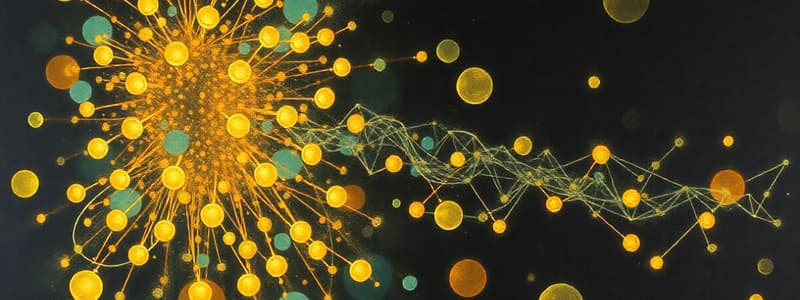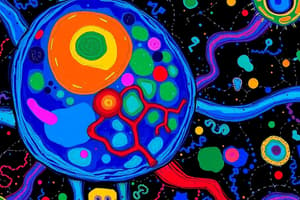Podcast
Questions and Answers
In negative autoregulation (NAR), X is a transcription factor that represses its own ______.
In negative autoregulation (NAR), X is a transcription factor that represses its own ______.
promoter
In positive autoregulation (PAR), X activates its own ______.
In positive autoregulation (PAR), X activates its own ______.
promoter
NAR speeds the response time relative to a simple-regulation system that reaches the same steady-state ______.
NAR speeds the response time relative to a simple-regulation system that reaches the same steady-state ______.
expression
The eight types of feedforward loops (FFLs) are classified into coherent and ______ FFLs.
The eight types of feedforward loops (FFLs) are classified into coherent and ______ FFLs.
In a type 1 Coherent Feed Forward Loop, the promoter displays ______ logic, requiring binding of both X and Y to be active.
In a type 1 Coherent Feed Forward Loop, the promoter displays ______ logic, requiring binding of both X and Y to be active.
Coherent feed forward loop results in delay of 'on' response and has no effect on 'off' response, while incoherent feed forward loop can speed up response time compared to simple ______.
Coherent feed forward loop results in delay of 'on' response and has no effect on 'off' response, while incoherent feed forward loop can speed up response time compared to simple ______.
A coherent feed forward network can act as a ______ filter, helping to filter out small perturbations.
A coherent feed forward network can act as a ______ filter, helping to filter out small perturbations.
The pulse response of an incoherent feed-forward loop can be sharp depending on the strength of ______.
The pulse response of an incoherent feed-forward loop can be sharp depending on the strength of ______.
Incoherent feed forward loops can use stronger promoters to speed the ______ response.
Incoherent feed forward loops can use stronger promoters to speed the ______ response.
There are 199 possible four node connected ______ within network motifs.
There are 199 possible four node connected ______ within network motifs.
Biological Systems are controlled by complex ______ networks.
Biological Systems are controlled by complex ______ networks.
Quantitative understanding of organisation and functioning of biological systems includes ______ analysis.
Quantitative understanding of organisation and functioning of biological systems includes ______ analysis.
The law of ______ action describes the rates of chemical reactions.
The law of ______ action describes the rates of chemical reactions.
In enzyme catalysed reactions, the enzyme is represented as ______.
In enzyme catalysed reactions, the enzyme is represented as ______.
The concentration of the intermediate enzyme substrate complex does not change with ______.
The concentration of the intermediate enzyme substrate complex does not change with ______.
Negative and positive auto regulation can speed up or slow down the ______ response.
Negative and positive auto regulation can speed up or slow down the ______ response.
The degradation rate, represented as ______, determines the response time in transcription networks.
The degradation rate, represented as ______, determines the response time in transcription networks.
Analysis of ______ regulatory networks is essential for understanding gene expression.
Analysis of ______ regulatory networks is essential for understanding gene expression.
Systems biology utilizes various omics approaches including genomics and ______.
Systems biology utilizes various omics approaches including genomics and ______.
Transcription networks respond to external ______.
Transcription networks respond to external ______.
What is one effect of an incoherent feed-forward loop compared to simple regulation?
What is one effect of an incoherent feed-forward loop compared to simple regulation?
How can a transcriptional network increase its response speed?
How can a transcriptional network increase its response speed?
What characterizes the pulse response of an incoherent feed-forward network?
What characterizes the pulse response of an incoherent feed-forward network?
What is the role of coherent feed forward loops in relation to noise in a network?
What is the role of coherent feed forward loops in relation to noise in a network?
In a transcriptional network with four nodes, how many possible connected graphs exist?
In a transcriptional network with four nodes, how many possible connected graphs exist?
What is the key characteristic of a negative autoregulation (NAR) system?
What is the key characteristic of a negative autoregulation (NAR) system?
How does positive autoregulation (PAR) affect the response time of transcription?
How does positive autoregulation (PAR) affect the response time of transcription?
In feedforward loops, what defines a coherent feedforward loop?
In feedforward loops, what defines a coherent feedforward loop?
Which type of logic does the promoter utilize in a type 1 coherent feedforward loop?
Which type of logic does the promoter utilize in a type 1 coherent feedforward loop?
What is one of the eight types of feedforward loops (FFLs) classified based on input characteristics?
What is one of the eight types of feedforward loops (FFLs) classified based on input characteristics?
Which of the following is a key component necessary for the quantitative analysis in systems biology?
Which of the following is a key component necessary for the quantitative analysis in systems biology?
What does the quasi-steady state assumption imply in enzyme catalyzed reactions?
What does the quasi-steady state assumption imply in enzyme catalyzed reactions?
How does negative autoregulation influence transcription factor response times?
How does negative autoregulation influence transcription factor response times?
Which of the following analyses is NOT part of understanding temporal networks in systems biology?
Which of the following analyses is NOT part of understanding temporal networks in systems biology?
Which of the following accurately describes positive regulation in transcription networks?
Which of the following accurately describes positive regulation in transcription networks?
What is a primary focus of spatial networks in systems biology?
What is a primary focus of spatial networks in systems biology?
Which statement about enzyme catalyzed reactions is true?
Which statement about enzyme catalyzed reactions is true?
Which of the following best explains the role of feedback in biological networks?
Which of the following best explains the role of feedback in biological networks?
Which concept is critical for understanding gene regulatory networks?
Which concept is critical for understanding gene regulatory networks?
What does the Law of Mass Action describe in the context of biochemical reactions?
What does the Law of Mass Action describe in the context of biochemical reactions?
Flashcards
Systems Biology
Systems Biology
Quantitative study of biological systems, examining components, reactions, and their spatial/temporal networks to understand emergent properties and functions.
Temporal Analysis
Temporal Analysis
Study of how biological processes change over time, including reaction kinetics and dynamics.
Reaction Networks
Reaction Networks
Sets of interconnected biochemical reactions, encompassing signalling, gene regulation, and metabolism.
Enzyme Kinetics
Enzyme Kinetics
Signup and view all the flashcards
Michaelis-Menten Kinetics
Michaelis-Menten Kinetics
Signup and view all the flashcards
Quasi-steady-state assumption
Quasi-steady-state assumption
Signup and view all the flashcards
Gene Regulatory Networks
Gene Regulatory Networks
Signup and view all the flashcards
Positive Regulation
Positive Regulation
Signup and view all the flashcards
Negative Regulation
Negative Regulation
Signup and view all the flashcards
Autoregulation
Autoregulation
Signup and view all the flashcards
Positive Autoregulation (PAR)
Positive Autoregulation (PAR)
Signup and view all the flashcards
Negative Autoregulation (NAR)
Negative Autoregulation (NAR)
Signup and view all the flashcards
Coherent Feed-Forward Loop
Coherent Feed-Forward Loop
Signup and view all the flashcards
Incoherent Feed-Forward Loop
Incoherent Feed-Forward Loop
Signup and view all the flashcards
AND Logic in 3-node FFL
AND Logic in 3-node FFL
Signup and view all the flashcards
Coherent Feed-Forward Loop (CFFL)
Coherent Feed-Forward Loop (CFFL)
Signup and view all the flashcards
Incoherent Feed-Forward Loop (IFFL)
Incoherent Feed-Forward Loop (IFFL)
Signup and view all the flashcards
Pulse-like dynamics in IFFL
Pulse-like dynamics in IFFL
Signup and view all the flashcards
Repression strength in IFFL
Repression strength in IFFL
Signup and view all the flashcards
Speeding up response time
Speeding up response time
Signup and view all the flashcards
Temporal Network Analysis
Temporal Network Analysis
Signup and view all the flashcards
Simple Transcription Model
Simple Transcription Model
Signup and view all the flashcards
What does PAR do to response time?
What does PAR do to response time?
Signup and view all the flashcards
What is a coherent feed-forward loop?
What is a coherent feed-forward loop?
Signup and view all the flashcards
What does a type 1 CFFL require?
What does a type 1 CFFL require?
Signup and view all the flashcards
How is response time affected with IFFL?
How is response time affected with IFFL?
Signup and view all the flashcards
What does a 3-node feed-forward loop consist of?
What does a 3-node feed-forward loop consist of?
Signup and view all the flashcards
Study Notes
Introduction to Systems Biology
- Biological systems are controlled by complex regulatory networks
- These networks span a wide range of space and time scales
Temporal Reaction Networks
- Biochemical reactions
- Signaling networks
- Gene regulatory networks
Analysis
- Transcription
- Positive and negative feedback
- Simple network motifs
- More complex motifs
Enzyme Catalysed Reactions
- Law of Mass Action/Michaelis Menten kinetics
- Formulas for enzyme-catalysed reactions are shown
- Enzyme acts as a catalyst and is conserved in the reaction: [E] + [ES] = [E]o
- Defining variables (E, ES, E, S, P, Kfwd, Krev, Kcat)
Quasi Steady State Assumption
- Assumed that the concentration of the enzyme-substrate complex does not change with time
- This assumption simplifies the equations
Michaelis-Menten Equation
- A derived equation that describes the rate of an enzyme-catalysed reaction
- v = (Vmax*[S])/(Km + [S])
Complex Networks
- Underlying critical biological functions
- Examples of complex networks are: metabolic pathways, E. coli gene regulatory network
- Quantitative understanding of organisation and functioning of biological systems is a goal of Systems Biology
Systems Biology ≈ Network Biology
- Goal: Develop a quantitative understanding of the function of genetic and biochemical networks
- Need to consider the function of individual interactions (feedbacks and feedforwards) within the context of the whole network
- Function of gene products A-F
- System approach
Analysis of Gene Regulatory Networks
- Simple transcription models
- DNA, Promoter, Gene, mRNA, RNA polymerase, Protein, Translation, Transcription are involved.
Transcription Networks
- Respond to external signals
- Shows signals and transcription factors
- Shows how genes are involved
Simple Positive Regulation
- Shows the activator and how it affects the binding site of the gene
- Equations for steady state and half time are included
Kinetics of Y Accumulation
- Shows accumulation of Y over time and its decay
- Graph of Y(t) = Yst (1 - e-at)
Negative and Positive Autoregulation
- Speed up/slow down the promoter response
3 Node Feed Forward Loops
- Coherent and incoherent types
- Shows the different possible types
- Coherent feed forward loops results in delay of "on" response, and incoherent feed forward loop speeds up the response time
Coherent Feed Forward Network
- Can filter out small perturbations (noise filter)
Three Node Incoherent Network
- Results in pulse-like dynamics
- Can be sharp pulse if repression strength is high
Generalisation of Feed Forward Loop
- Double input, double Y, double output
Multi Node Generalisations of Feed Forward Loop
- Multi input, Multi Y, Multi output
4 Node Networks
- 199 possible four node connected graphs
Transcription response speed up
- Three ways to increase response speed
- Increase degradation rate of a gene to speed up the simple response
- Use negative feedback promoters, thereby speeding up the initial response
- Use incoherent feed-forward loops to speed up the initial response
Studying That Suits You
Use AI to generate personalized quizzes and flashcards to suit your learning preferences.




